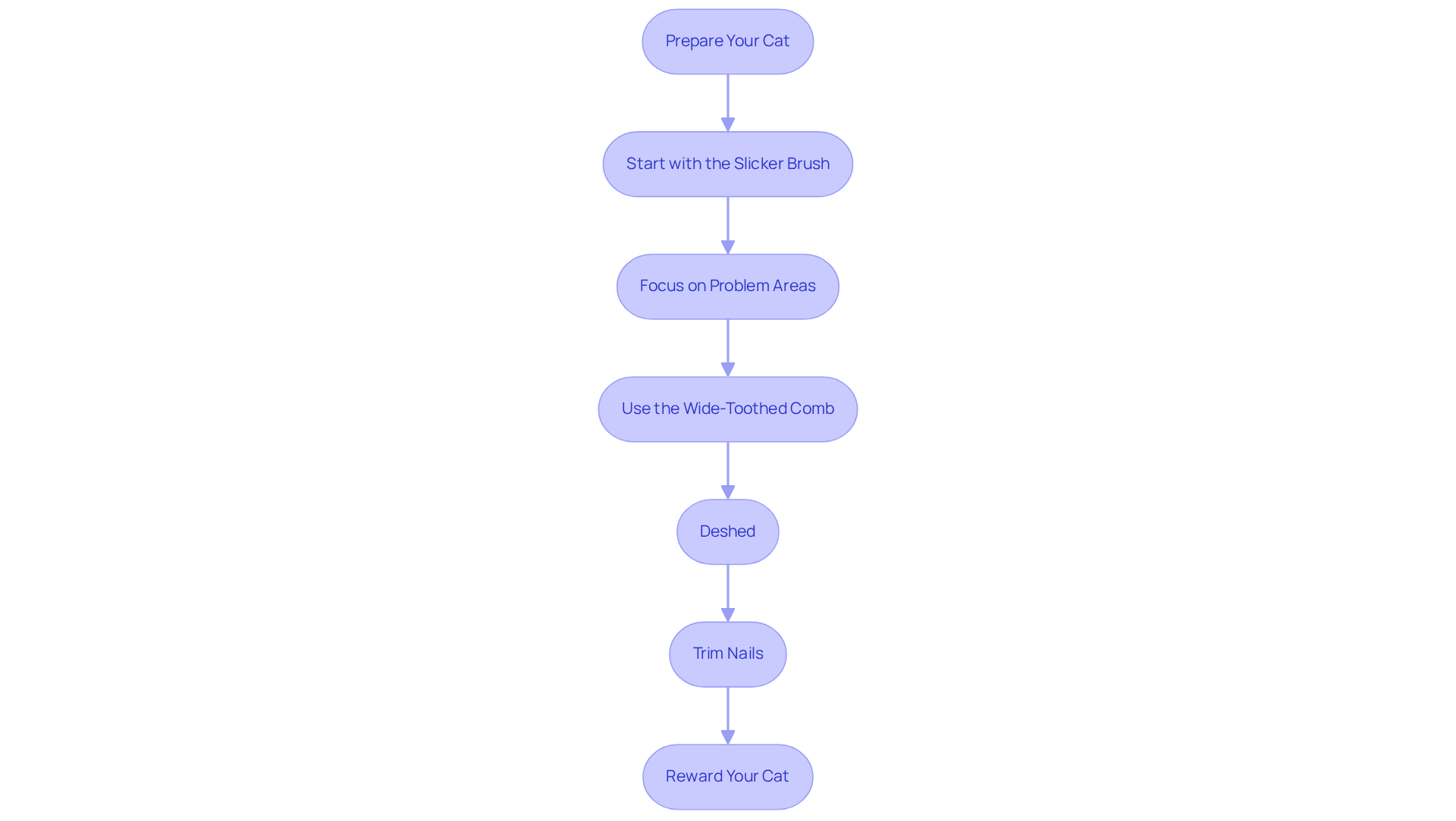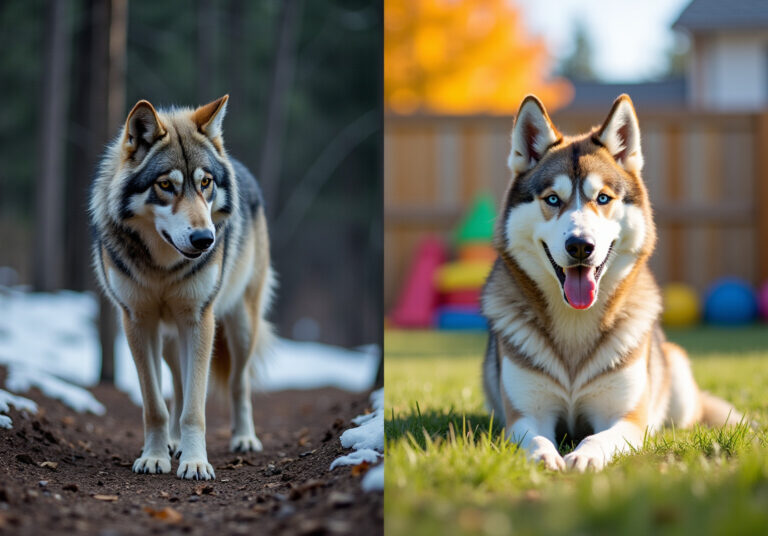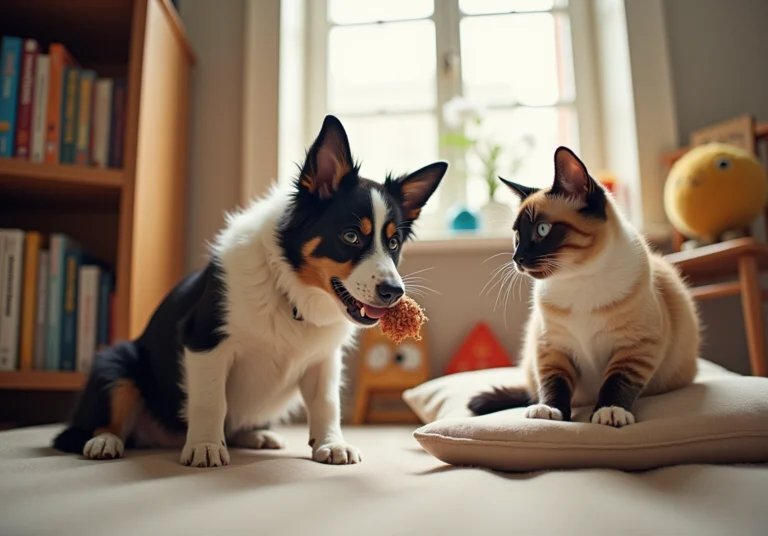Master Grooming Your Long Haired Cat with Essential Tools and Steps
Overview
This article lovingly explores the art of grooming long-haired cats, highlighting the essential tools and a thoughtful step-by-step process. We understand that as a pet owner, you want nothing but the best for your furry family members. By using the right tools, such as:
- Slicker brushes
- Deshedding tools
and establishing a structured grooming routine, you can ensure your cat’s coat remains healthy and vibrant. This nurturing approach not only enhances your pet’s well-being but also strengthens the bond between you and your beloved companion. Embrace this journey of care, and watch as your relationship flourishes through the simple act of grooming.
Introduction
Grooming your long-haired cat is not just a beauty routine; it’s a vital part of their health and well-being. With the right tools and techniques, you can transform what may feel like a daunting task into a rewarding bonding experience with your furry family member.
However, many pet owners encounter challenges along the way, from stubborn mats to sensitive areas that require extra care. How can you navigate these hurdles while ensuring your feline friend remains comfortable and happy?
This guide explores essential grooming tools, step-by-step processes, and effective strategies to overcome common grooming obstacles, empowering you to master the art of grooming your long-haired companion.
Gather Essential Grooming Tools
To groom your long-haired cat effectively, you will need the following essential tools:
- Slicker Brush: This implement is perfect for removing loose hair and detangling mats. Opt for one with fine, bent wires that can penetrate deep into the coat, ensuring thorough grooming.
- Wide-Toothed Comb: Ideal for detangling and smoothing fur, especially in sensitive areas like the belly and behind the ears, this comb is a must-have for maintaining your cat’s coat.
- Deshedding Tool: To reduce shedding and prevent hairballs, a deshedding tool like the FURminator is highly recommended. It effectively removes undercoat fur, making it a favorite among pet owners.
- Pin Brush: Excellent for daily care, this brush aids in spreading natural oils across the coat, maintaining its luster and vitality.
- Mat Splitter or Dematting Device: Essential for tackling stubborn mats, these implements allow you to address tangles without causing discomfort to your cat.
- Nail Clippers: Regular nail trimming is crucial for your cat’s health and comfort, preventing overgrowth and potential injury.
- Grooming Mitts: These mitts not only assist in eliminating loose fur but also offer a gentle massage, enhancing the bathing experience for your cat.
Make sure all equipment is clean and in proper condition before beginning the cleaning process. With the appropriate equipment, you can efficiently care for your long-haired cat’s coat, aiding in their overall health and well-being. The U.S. pet care products market is expected to expand at a CAGR of 5.47% until 2030, indicating the rising need for quality care instruments. Investing in effective care tools not only improves the look of a long-haired cat but also promotes their health, as regular maintenance is vital for these breeds.
Follow a Step-by-Step Grooming Process
To groom your long-haired cat effectively, follow these essential steps:
- Prepare Your Cat: Create a quiet, comfortable space for grooming. Allow your furry friend to explore the area and familiarize themselves with the equipment, ensuring they feel secure.
- Start with the Slicker Brush: Begin at the head and gently brush down their body, following the direction of hair growth to minimize any discomfort.
- Focus on Problem Areas: Pay extra attention to those spots prone to matting, like the armpits, belly, and behind the ears. If you encounter tangles, a mat splitter can be a helpful tool.
- Use the Wide-Toothed Comb: After brushing, use a wide-toothed comb to detangle and smooth the fur, effectively removing any loose hair.
- Deshed: Employ a deshedding tool to eliminate undercoat fur, especially during shedding seasons when loose hair is abundant.
- Trim Nails: Carefully trim your cat’s nails, steering clear of the quick (the pink part of the nail) to prevent discomfort.
- Reward Your Cat: After tidying, offer treats or engage in playtime to foster a positive association with the grooming process.
Aim to repeat this care routine for your long-haired cat at least once a week, or more frequently if their coat is thick or prone to matting. Routine care is vital, as studies indicate that up to 50% of a cat’s day is devoted to cleaning themselves, highlighting their natural tendency to maintain their coat. Furthermore, 84% of pet owners tend to their pets at least once a year, emphasizing the significance of creating a regular care routine. By integrating these practices, you not only ensure your cat’s coat remains healthy but also strengthen the bond between you and your feline family member.

Troubleshoot Common Grooming Challenges
Grooming your long haired cat can present various challenges, but with the right strategies, you can navigate these issues effectively. Many pet owners share your concerns, and here are some common grooming challenges along with their nurturing solutions:
- Matted Fur: Encountering mats in your cat’s fur is common. Use a mat splitter or dematting tool to gently separate the mat from the skin. If the mat is too tight or extensive, it may be best to consult a professional groomer to avoid causing discomfort. Remember, a long haired cat might require maintenance every 4-6 weeks to prevent tangling.
- Cat Resistance: Many felines oppose being brushed, which can be frustrating. To make personal care more enjoyable, incorporate treats or toys into the process. Start with short care sessions, gradually extending the time as your cat becomes more familiar with the routine. Did you know that 41% of dog owners tend to their pets at home, while 30% take them to a full-service salon? This trend in pet care behaviors can also apply to our beloved cats.
- Sensitive Areas: Cats often have sensitive spots, especially around their belly and paws. Approach these areas with gentle strokes, allowing your cat to guide the process. If your cat shows signs of discomfort, pause and try again later to avoid stress.
- Excessive Shedding: If your cat is shedding excessively, ensure they are on a balanced diet rich in essential nutrients. Increasing the frequency of grooming sessions can also help manage loose fur. Utilizing a deshedding device can effectively reduce shedding and keep your home cleaner.
- Skin Irritation: If you observe any redness or irritation while caring for your pet, stop immediately and consult your veterinarian. It’s essential to ensure that all care tools are clean and suitable for your cat’s specific skin type to avoid additional problems. As experts remind us, “Professional care isn’t just about keeping your cat looking great—it’s about enhancing their overall health and happiness.”
By preparing for these common challenges, you can create a more positive grooming experience for both you and your furry family member. Embrace the journey of grooming with love and patience, and your care will be appreciated by your long-haired cat.
Conclusion
Grooming a long-haired cat transcends mere aesthetics; it is vital for their overall health and well-being. By using the right tools and adhering to a structured grooming process, pet owners can ensure their furry companions remain comfortable, happy, and free from tangles and mats. The significance of regular grooming cannot be overstated, as it helps prevent issues like excessive shedding and skin irritation, all while nurturing a stronger bond between pet and owner.
In this article, we explored essential tools such as:
- Slicker brushes
- Wide-toothed combs
- Deshedding devices
Alongside a step-by-step grooming process designed to make the experience enjoyable for both the cat and the owner. Common challenges—like matting, cat resistance, and sensitive areas—were addressed, providing practical solutions to enhance the grooming experience. Regular grooming not only keeps your cat’s coat looking its best but also contributes to their overall health, emphasizing the necessity of incorporating these practices into your routine care.
Investing time and effort into grooming your long-haired cat is truly an investment in their health and happiness. Embrace the grooming journey with patience and love, remembering that each session strengthens the bond you share with your beloved pet. By making grooming a regular part of your cat care routine, you not only keep your home tidy but also ensure that your long-haired companion enjoys a vibrant, healthy coat.
Frequently Asked Questions
What essential grooming tools do I need for my long-haired cat?
The essential grooming tools for a long-haired cat include a slicker brush, wide-toothed comb, deshedding tool, pin brush, mat splitter or dematting device, nail clippers, and grooming mitts.
What is the purpose of a slicker brush?
A slicker brush is used to remove loose hair and detangle mats, featuring fine, bent wires that penetrate deep into the coat for thorough grooming.
How does a wide-toothed comb help in grooming?
A wide-toothed comb is ideal for detangling and smoothing fur, especially in sensitive areas like the belly and behind the ears.
Why should I use a deshedding tool?
A deshedding tool, like the FURminator, helps reduce shedding and prevent hairballs by effectively removing undercoat fur.
What is the function of a pin brush?
A pin brush is excellent for daily care as it aids in spreading natural oils across the coat, maintaining its luster and vitality.
When should I use a mat splitter or dematting device?
A mat splitter or dematting device is essential for tackling stubborn mats and tangles without causing discomfort to your cat.
Why is regular nail trimming important for my cat?
Regular nail trimming is crucial for your cat’s health and comfort, as it prevents overgrowth and potential injury.
What benefits do grooming mitts provide?
Grooming mitts help eliminate loose fur and provide a gentle massage, enhancing the bathing experience for your cat.
How can I ensure my grooming tools are effective?
Make sure all grooming equipment is clean and in proper condition before starting the grooming process.
Why is regular grooming important for long-haired cats?
Regular grooming is vital for long-haired cats as it improves their appearance and promotes their overall health and well-being.







